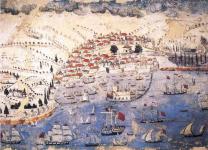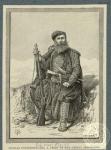

The ottomans maintained the fortification and
the urban fabric of the Venetian Candia. In fact, given the importance of the
city as a fortress, there began, after the establishment of the new
authorities, a systematic recording of the most important public and private
buildings, the underground grain storehouses, the water cisterns and the
churches. Immediate repairs were carried out on the walls along with some minor
additions (the St. Andreas bastion, the small Koules etc.), the water supply
from the springs of Archanes (Kemer Suyu), which was cut during the siege, was
restored and new water collection and distribution cisterns were built.
Additional water supply for the mosques, dens, baths, jets and fountains
(charitable, public and private) of the city was attempted from the smaller
springs of the surrounding area. A great utilitarian
project of the time was the construction of the drainage system which included
the building of two closed masonry culverts in key city locations. The ottoman
troops were housed in the venetian barracks of St George (Imperial
Janissaries), those at the gate of Jesus and the «Haunt of the Pit». In
the place of the monastery of Akrotiriani the kisla of the local janissaries
was built, while prisons and public granaries continued to operate in the
Volonte gate of the arab-byzantine- old venetian walls and the adjacent
venetian Fontaco to the east. The other public buildings were used to
house senior ottoman officials who were granted imperial permission by Kiopruli
himself to convert fifteen Christian churches, and later a further eight, to
mosques provided they dedicated residential property for their maintenance.
Furthermore, a substantial number of small churches like Panagia Faneromeni in
Martinengo, were converted to houses of prayer (mescid) and dens for the Muslim
clergy. A different case is that of the large den of the Mbektasides of Ali
Dede Chorasanli, which was built during the siege in the place of the venetian
settlement ´Kaiafa´ in present day suburb “Ampelokipi”. Smaller churches
and some of the private chapels in the luxury homes that came under ottoman
officials were also converted into baths (hamams). We also know of the
existence of nine public baths. The city's reconstruction projects were carried
out in their entirety by the Armenians miners of the Ottoman army and some
local specialized castle-builders.
With the exception of the small one-room homes
in the poor districts of the city’s fringes, Renaissance Venetian mansions
uniquely interacted with houses of Balkan architecture and neoclassical
mansions, thus transforming the cobbled alleyways of the city into carriers of
its legend. Behind the wooden lattice screens of the windows and confined
within the high walls that surrounded the courtyard, Ottoman houses enclosed
fairytale worlds. Painted wooden ceilings, mousantres and partitions, and
magnificent pebbled yards with hazinedes, wells and peacocks in lush vegetation
was the magical image of Candia’s East.
Τhe old Jewish community and the synagogue remained within the city, in
the area between the mosque of Sultan Ibrahim (Venetian monastery of St.
Andreas) and the gate of sand (Kum Kapu) of Dermata bay.
The wall towers of the Holy Spirit (Τasli Ntambia) = rocky rampart),
Pantocrator and Aghios Nikolaos and the St. Demetrious (Ακ Ntambia = white
rampart) fortress were preserved on the outside of the strong city walls. The
guarded area of Top Altis was situated inside the moat of the fortress of
Candia, where the land was from the beginning divided into areas for crop and
animal husbandry and burials. So, the two large Muslim cemeteries were built close
to the gates of Pantocrator and Jesus, among lush vineyards were.
Finally, because the gates of the castle were
closing at sunset and opening again at sunrise, those who failed to get in the city in time could spend
the night in vaulted lodgings situated near springs that were especially
adapted to house them and their animals, such as the one at “koroni Magara” and
“koumbedes” on the road to Chania.
The "most beautiful city of the
East", often suffered natural disasters. Earthquakes leveled the mighty
buildings and fires swept the masterpieces of Balkan architecture with the
wooden floors. Finally, in the 20th century, "expansion",
urbanization and modern lifestyles further wounded the historic character of
the city.
1. gr// Επιτροπάκης Π., gr// Το Ηράκλειο στους Οθωμανικούς χρόνους, gr// Η Οθωμανική αρχιτεκτονική στην Ελλάδα, gr// Αθήνα, gr// 2008, p. gr// 396-397 More
 | 6. The Great Castle (Kandiye) | |
|---|---|---|
 | 6.1 Crete during the Ottoman occupation | |
 | 6.3 The rebellion of Daskalogiannis (1770) |